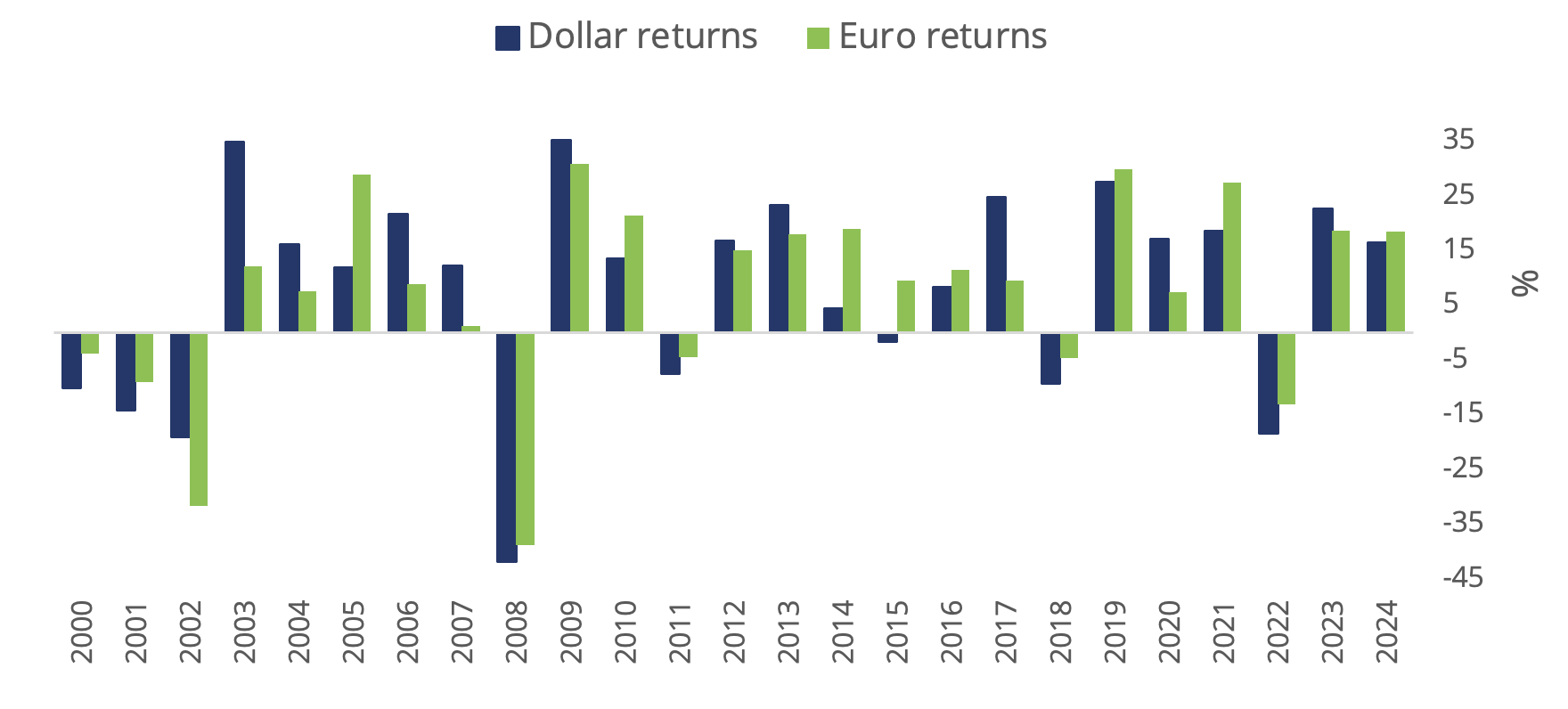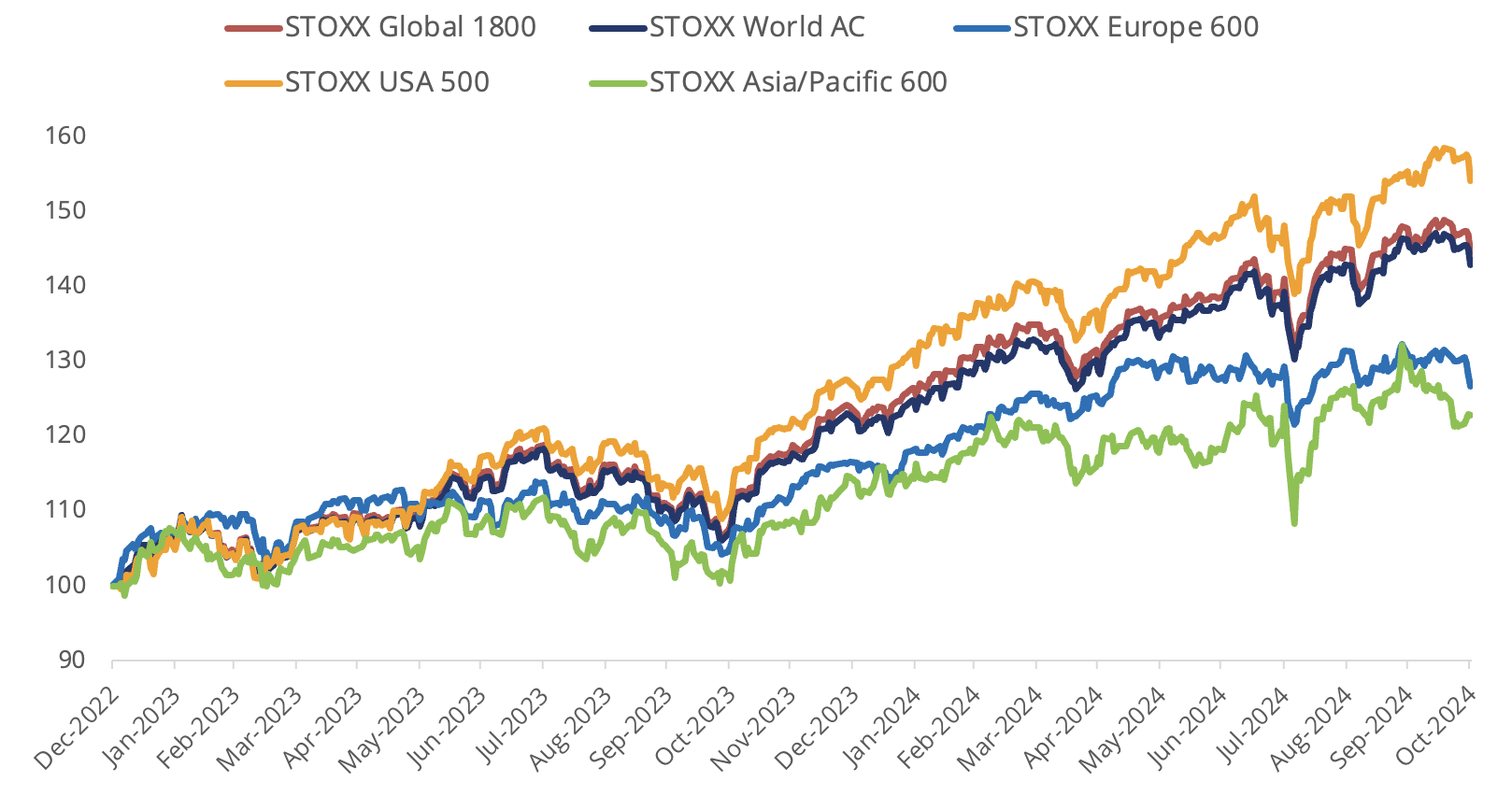Stocks fell for the first month in six in October as earnings disappointments from technology companies and rising bond yields drove investors to take profits from this year’s rally.
The STOXX® World AC index fell 2.3% last month when measured in US dollars and including dividends[1], parings its 2024 gain to 16.4%. The global benchmark rose 0.5% in euros over the month as the greenback climbed 2.7% against the common currency. The STOXX® Global 1800 index fell 2.1% in dollars in October.
The Eurozone’s EURO STOXX 50® slid 3.3% in euros on a total-return basis, while the pan-European STOXX® Europe 600 fell 3.2%.[2] The STOXX® North America 600 fell 0.8% in dollars and the STOXX® USA 500 declined 0.7%. The STOXX®Asia/Pacific 600 shed 4.9% in dollars. The STOXX® Developed World dropped 2% and the STOXX® Emerging Markets fell 4.5%.
Figure 1: STOXX Equity World indices’ October risk and return

Figure 2: STOXX Benchmark indices’ October risk and return

Germany’s DAX® decreased 1.3% in the month. MDAX®, which gauges the performance of German mid-caps, shed 2%.
Figure 3: DAX indices’ October risk and return

| For a complete review of all indices’ performance last month, visit our October index newsletter. |
GDP, inflation
The US economy expanded 2.8% in the third quarter, the government reported on October 30. Meanwhile, the disinflationary path continues. The personal consumption expenditures (PCE) price index, closely watched by the Federal Reserve, rose by an annual 2.1% in September, the smallest year-on-year rise since February 2021.[3] The US central bank on September 18 lowered the benchmark federal funds rate by half a percentage point to a 4.75%-5% range.
Bonds fell during the month amid a resilient economic picture in the US and as traders lowered expectations for the pace of rate cuts. The yield on 10-year US Treasurys rose to 4.27% at the end of October from 3.80% at the end of September.
October’s last session was also the worst one, with the STOXX World AC dropping 1.5% after Microsoft Inc. and Meta Platforms Inc. released outlooks that were not well received by investors. Both companies beat quarterly earnings estimates but indicated they will spend more capital in artificial intelligence. NVIDIA Corp., which has become a bellwether in the AI race and is now the world’s most valuable company, rose 13.5% in the month.
Figure 4: Total annual % returns for STOXX World AC index

Figure 5: Select STOXX benchmarks’ returns since 2023

Volatility rises
The VSTOXX® (EURO STOXX 50® Volatility), which tracks the price of EURO STOXX 50 options traded on Eurex, rose to 21.7 at the end of last month from 18.1 at the end of September. A higher VSTOXX reading suggests investors are paying up for puts that offer insurance against stock price drops. The VDAX-New®, which measures volatility in German equities, rose to 19.7 from 16.5 in September.
Factor investing
Among the STOXX Factor indices, the Size signal led losses last month, while Momentum was the best relative performer (Figure 6).
Figure 6: STOXX Factor (Global) indices’ October risk and return characteristics

Climate benchmarks
Within climate benchmarks, the STOXX® Global 1800 Paris-Aligned Benchmark (PAB) fell 2.9% and the STOXX® Global 1800 Climate Transition Benchmark (CTB) dropped 3%. The PAB and CTB indices follow the requirements outlined by the European Commission’s climate benchmarks regulation.
Sustainability indices
The STOXX® Global 1800 ESG-X index fell 2.2% in the month. The STOXX® ESG-X indices are versions of traditional, market-capitalization-weighted benchmarks that observe standard responsible exclusions.
Within indices that combine exclusions and best-in-class ESG integration, the EURO STOXX 50® ESG index lost 3.3% over the month. Germany’s DAX® 50 ESG index (-2.3%)[4], which excludes companies involved in controversial activities and integrates ESG scoring into stock selection, lagged behind the benchmark DAX in the month.
The STOXX® Global 1800 SRI fell 3%. The STOXX SRI indices apply a set of carbon emission intensity, compliance and involvement screens, and track the best ESG performers in each industry group within a selection of STOXX benchmarks.
Finally, the DAX® ESG Screened slid 2.3% in the month. The index reflects the composition of the DAX benchmark minus companies that fail to pass norms-based and controversial weapons screenings, meet minimum ESG ratings or are involved in certain business activities considered undesirable from a responsible investing perspective.
Thematics, digital assets
Seventeen of 36 STOXX® Thematic indices outperformed the benchmark STOXX Global 1800 last month. The STOXX® Global Silver Mining index (+5.9%) showed the largest advance, while the STOXX® Global Energy Storage and Materials index (-8.9%) led losses.
The STOXX® Digital Asset Blue Chip index, which aims to track high-quality assets that represent the crypto universe today, rose 3.5% in the month.
Dividend strategies
Dividend strategies performed poorly in the month that ended. The STOXX® Global Maximum Dividend 40 (-4.5% on a net basis) selects only the highest-yielding stocks. The STOXX® Global Select Dividend 100 (-3.4%) tracks companies with sizeable dividends but also applies a quality filter such as a history of stable payments.
Minimum variance
Minimum variance strategies had a mixed month relative to benchmarks. The STOXX® Global 1800 Minimum Variance fell 2.4% and the STOXX® Global 1800 Minimum Variance Unconstrained dropped 2.1%.
The STOXX Minimum Variance Indices come in two versions. A constrained version has similar exposure to its market capitalization-weighted benchmark but with lower risk. The unconstrained version, on the other hand, has more freedom to fulfill its minimum variance mandate within the same universe of stocks.
[1] All results are total returns before taxes unless specified.
[2] Throughout the article, all European indices are quoted in euros, while global, North America, US, Japan and Asia/Pacific indices are in US dollars.
[3] Reuters, “September US PCE inflation ticks up, as expected,” October 31, 2024.
[4] Figures in parentheses show last month’s gross returns.
